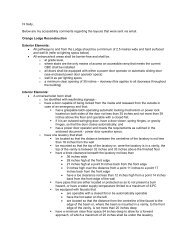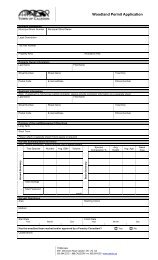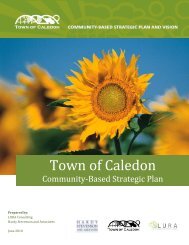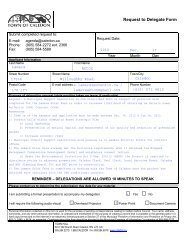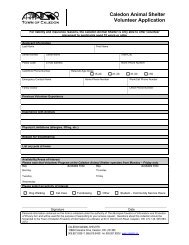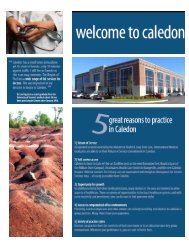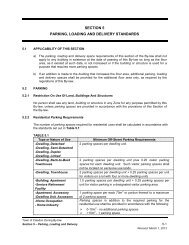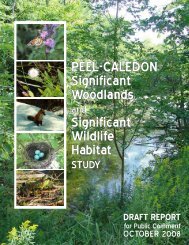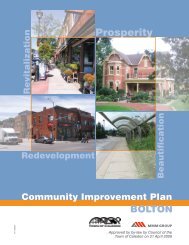Urban Design Guidelines - Town of Caledon
Urban Design Guidelines - Town of Caledon
Urban Design Guidelines - Town of Caledon
- No tags were found...
Create successful ePaper yourself
Turn your PDF publications into a flip-book with our unique Google optimized e-Paper software.
2.3.4. Green BuildingNew and retr<strong>of</strong>itted buildings should be moreenergy efficient, use less potable water andgenerate less waste than conventional buildings.Background - The <strong>Town</strong> has a Green DevelopmentProgram that provides municipal development chargediscounts for new green commercial and industrialbuildings. The eligible green technologies are: asolar hot water system, transpired solar collectors, asolar photovoltaic system, permeable pavement, andstormwater cistern. LEED Certification by the CanadaGreen Building Council will also enable developers tohave development charge discounts from 20% to 27.5%.master plan could enable potential developers to buyproperty strategically, (i.e., according to the potentialsharing <strong>of</strong> energy between neighbours, as opposedto simply following conventional criteria for real estateacquisition). Ultimately the idea is to position Bolton’sindustrial area as a desirable location for progressiveand environmentally conscious entrepreneurs.59<strong>Guidelines</strong>Much <strong>of</strong> the industrial area has already been developed,which means that the current Green DevelopmentProgram does not apply unless the existing buildingis replaced by a new structure. To complement it, theCIP includes a specific Energy Efficiency Retr<strong>of</strong>it GrantProgram to promote the retr<strong>of</strong>it <strong>of</strong> existing buildings tobecome more energy efficient.A long-term progressive measure would be to developa comprehensive sustainability master plan for theindustrial area that would analyze the current energy andwater inputs and outputs <strong>of</strong> each facility, and explorethe possibility <strong>of</strong> transferring energy and water betweenproperties. For example, a facility that refrigeratesgoods produces heat (in the refrigeration process) thatcould be reused by an adjacent facility. This kind <strong>of</strong>URBAN DESIGN GUIDELINESFINAL Bolton CIP <strong>Urban</strong> <strong>Design</strong> <strong>Guidelines</strong> | April 2009



